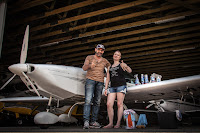This weekend I have spent 12 hours on a German Autobahn to travel from Munich to East of the German Capitla, Berlin:
Airport Strausberg was the destination.
WHY?
RUWE Aero, a flight academy for Microlight Aircrafts, owns a
Full-Motion-Flight Simulator, incl. the option to simulate the release of the
"Ballistic Recovery System".
With some folks from the airports EDML and EDMY we arrived on Friday midnight at Strausberg.
Sharp in time we met on Saturday morning Norbert, a very experienced former military pilot, in both German Airforces, (East- and later West-Germany), who is leading the "Microlight Safety Program" of RUWE Aero. A short introduction to the facility by Derek, the MD of RUWE Aero, and we started straight in the meeting room.
Firstly we got an overview of the current situation, including some typical causes for accidents with MicroLights.
We have been one, on the perception, that avoiding problems is the best way to stay away from dangerous situations. So we tried to identify the main root causes of critical situations, flying an aircraft.
And, in simple words, it's all about speed. Speed is uplift, and uplift is time.
But don't get me wrong: it's not about speed for itself, it's about the right speed. Many pilots are not aware of the "
best glide speed" of their aircraft. Being 4 mph faster or slower then it, eats your height within seconds away.
And this is a slogan we must not discuss:
HEIGHT IS TIME IS LIFE!
Our Microlight Aircrafts have glide factors of 1:10 to 1:15. This means if we move horizontal 10 m or 15 m, we lose 1meter in height. Being in a critical situation in a height of 500 m above the ground, we might move between 5.000 and 7.500 m! Not so bad, right?
Sounds cool, but there is one big thing to keep in mind: it works, as the gas consumption we get promised by the auto manufacturers, only under exactly defined regulations and environments.
One of the most critical key points is the
"best glide speed". And this speed is individual for each aircraft. Take your "Manual/Handbuch" and look out for it. Start seeking for in a critical situation is far too late!
And the difference between the 1:15 to a 1:7 is only a difference of + or - 3-5 mph!!!
Seeing the formulas, calculating some (typical) situations is one thing.
DOING it, would give evidence, that our assumptions and calculations are correct.
Instead of crashing plenty of aircrafts, we changed the scene, after our lunch with the team, to the RUWE Aero Microlight Simulator for the next level.
 |
| Steering dashboard |
 |
| Full-motion Simulator |
All our assumptions and calculations have been confirmed! Even if we experience a fatal engine failure, we have time enough (given we are in a certain height) to take decisions, to find good places to land, maybe to get back to our airfield, to prepare for landing.
And if we are not 500 or 800 ft AGL? It's much more crucial to safe EACH single foot of height!
Remember:
HEIGHT IS TIME IS LIFE!
No kidding around: even with that knowledge, good trained skills and calm blood we cannot recover all.
So finally we have simulated another scenario:
recognizing that there is NO RECOVERY possible!
We have the "Ballistic Recovery System", mandatory by law in Germany, equipped in our aircrafts!
So we brought our aircrafts (with good help of Hannes, the technical engineer from RUWE) in situations, where we had to decide:
do or die!
Do stands for PULL the RED HANDLE!
It may sound strange, but there was a constraint to pull this RED handle. Exactly what probably happened to some of the pilots, crashing fatally in the past months.
To recognize and to talk with the group about this very same experience, made all of us more "FREE" to pull the handle. As we could make the experience, that we couldn't recover a situation, where we BELIEVED we could, brought us closer to our limitations and boundaries.
We pulled, and we SURVIVED!
Limitations and borders are not bad, as long as we know them!
Special thanks to the Team of RUWE Aero and my flight mates for this great experience. You all made our future flights safer!
But one person, we regrettably did not meet on Saturday has to be mentioned extra:
in times where it seems only profit, KPIs and make more profit are THE values, he is taking all his passion for flying and offers this great program to ALL Microlight pilots for FREE.
Not to sell anything afterwards, but to make MICROLIGHT Flying more safe!
(And you can trust me: no hidden costs, no fees. Only for FREE.)
The RUWE Aero Team:
Derek Hans, Norbert, Hannes, Angelika
The EDMY/EDML Folks:
Stephan, Jan, Claudia, Roman, Andi























